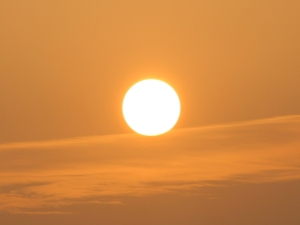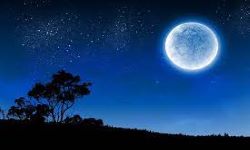The Luminarias
The Sun, the Moon and the Stars


December 14, 2022
On the fourth day God created the great luminary, that is, the sun, to have rule and authority over the day: for it is by it that day is made: for it is day when the sun is above the earth, and the duration of a day is the course of the sun over the earth from its rising till its setting. He also created the lesser luminaries, that is, the moon and the stars, to have rule and authority over the night, and to give light by night. For it is night when the sun is under the earth, and the duration of night is the course of the sun under the earth from its rising till its setting. The moon, then, and the stars were set to lighten the night: not that they are in the daytime under the earth, for even by day stars are in the heaven over the earth but the sun conceals both the stars and the moon by the greater brilliance of its light and prevents them from being seen.
On these luminaries the Creator bestowed the first-created light: not because He was in need of other light, but that that light might not remain idle. For a luminary is not merely light, but a vessel for containing light .
It is through the Sun that the four seasons are brought about. And the first of these is spring: for in it God created all things , and even down to the present time its presence is evidenced by the bursting of the flowers into bud, and this is the equinoctial period, since day and night each consist of twelve hours. It is caused by the sun rising in the middle, and is mild and increases the blood, and is warm and moist, and holds a position midway between winter and summer, being warmer and drier than winter, but colder and moister than summer.
But the moon traverses the twelve signs each month, since it occupies a lower position and travels through the signs at a quicker rate. For if you draw one circle within another, the inner one will be found to be the lesser: and so it is that owing to the moon occupying a lower position its course is shorter and is sooner completed
We hold that the stars are not the causes of the things that occur, nor of the origin of things that come to pass, nor of the destruction of those things that perish. They are rather signs of showers and changes of air. But, perhaps, some one may say that though they are not the causes of wars, yet they are signs of them. And, in truth, the quality of the air which is produced by sun, and moon, and stars, produces in various ways different temperaments, and habits, and dispositions . But the habits are amongst the things that we have in our own hands, for it is reason that rules, and directs, and changes them.
So not even that star which the Magi saw at the birth of the Friend and Saviour of man, our Lord, Who became flesh for our sake, is of the number of those that were made in the beginning. And this is evidently the case because sometimes its course was from east to west, and sometimes from north to south; at one moment it was hidden, and at the next it was revealed: which is quite out of harmony with the order and nature of the stars.
It must be understood, then, that the moon derives its light from the sun; not that God was unable to grant it light of its own, but in order that rhythm and order may be unimpressed upon nature, one part ruling, the other being ruled, and that we might thus be taught to live in community and to share our possessions with one another, and to be under subjection, first to our Maker and Creator, our God and Master, and then also to the rulers set in authority over us by Him: and not to question why this man is ruler and not I myself, but to welcome all that comes from God in a gracious and reasonable spirit.
The sun and the moon, moreover, suffer eclipse, and this demonstrates the folly of those who worship the creature in place of the Creator , and teaches us how changeable and alterable all things are For all things are changeable save God, and whatever is changeable is liable to corruption in accordance with the laws of its own nature.
Now the cause of the eclipse of the sun is that the body of the moon is interposed like a partition-wall and casts a shadow, and prevents the light from being shed down on us : and the extent of the eclipse is proportional to the size of the moon’s body that is found to conceal the sun. But do not marvel that the moon’s body is the smaller. For many declare that the sun is many times larger even than the earth, and the holy Fathers say that it is equal to the earth: yet often a small cloud, or even a small hill or a wall quite conceals it.
The eclipse of the moon, on the other hand, is due to the shadow the earth casts on it when it is a fifteen days’ moon and the sun and moon happen to be at the opposite poles of the highest circle, the sun being under the earth and the moon above the earth. For the earth casts a shadow and the sun’s light is prevented from illuminating the moon, and therefore it is then eclipsed.
It should be understood that the moon was made full by the Creator, that is, a fifteen days’ moon: for it was fitting that it should be made complete . But on the fourth day, as we said, the sun was created. Therefore the moon was eleven days in advance of the sun, because from the fourth to the fifteenth day there are eleven days. Hence it happens that in each year the twelve months of the moon contain eleven days fewer than the twelve months of the sun. For the twelve months of the sun contain three hundred and sixty-five and a quarter days, and so because the quarter becomes a whole, in four years an extra day is completed, which is called bis-sextile. And that year has three hundred and sixty-six days. The years of the moon, on the other hand, have three hundred and fifty-four days. For the moon wanes from the time of its origin, or renewal, till it is fourteen and three-quarter days’ old, and proceeds to wane till the twenty-ninth and a half day, when it is completely void of light And then when it is once more connected with the sun it is reproduced and renewed, a memorial of our resurrection. Thus in each year the moon gives away eleven days to the sun, and so in three years the intercalary month of the Hebrews arises, and that year comes to consist of thirteen months, owing to the addition of these eleven days .
It is evident that both sun and moon and stars are compound and liable to corruption according to the laws of their various natures. But of their nature we are ignorant. Some, indeed, say that fire when deprived of matter is invisible, and thus, that when it is quenched it vanishes altogether. Others, again, say that when it is quenched it is transformed into air .
Source:- Homily on Orthodox Church of The Mother of God
